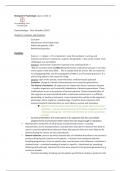Class notes
Biologische Psychologie - Aantekeningen ALLE colleges (1 t/m 13) 22-23
- Course
- Institution
Uitgebreide aantekeningen van college 1 tm 13 voor het tweedejaars vak Biologische psychologie Bij het kopen van deze samenvatting kan ik je de pdf van het boek gratis mailen! Stuur me dan even een berichtje!
[Show more]



